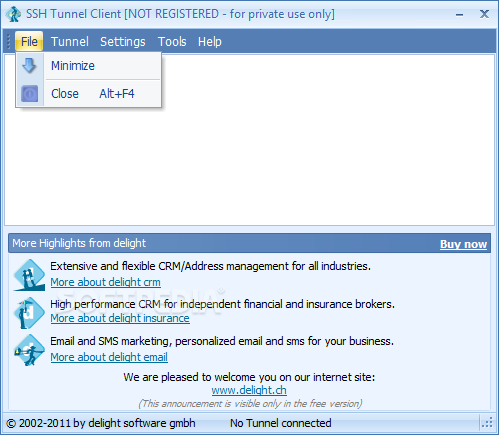

Is the server running locally and acceptingĬonnections on Unix domain socket "/var/run/postgresql/.s.PGSQL.5432"? I have in fact to problems : I can't forward the 5432 port using the ssh command :īy inserting 5432:Server_A:5432 in the ssh command to forward the 5432 port, I have this error : psql: could not connect to server: No such file or directory This machine can connect itself to the database using this command : psql -h Server_A -p 5432 -d db_name -U user My problem is that I want to reproduce the connection done from a machine present in the network of Server_B. To access to postgreSQl on Server_B, I can easily forward ports like this : ssh -L 54320:Server_A:5432 in another terminal : psql -p 54320 -d db_name -U user This server is on a local network, that's why I have to forward port from Server_B which is accessible and in the same network.
#SSH TUNNEL POSTGRES DRIVER#
Solutions for common Laravel Dusk driver problems.I try to access to a Server_A on which PostgreSQL is running.Installing a private package with Composer.I'd love your feedback on this article, either positive or negative, let me know in the comments. That is all there is to it! Hope this helped you get up and running. Connecting to the remote databaseĮverything should be set up and we should be able to retrieve records from the remote database like this: $records = DB::connection( 'remote_mysql') The thing to pay attention to is the port, this should match the local port we set up in our SSH command. 'password' => env( 'REMOTE_DB_PASSWORD', ''), 'username' => env( 'REMOTE_DB_USERNAME', 'forge'), Wherever the information is sent, it will appear to have originated from the server that youre currently connected to via SSH. 'database' => env( 'REMOTE_DB_DATABASE', 'forge'), SSH uses client-server architecture, connecting an SSH client with an SSH server. Secure Shell (SSH) is cryptographic network protocol for secure remote login, command execution and file transfer over untrusted networks.
#SSH TUNNEL POSTGRES HOW TO#
'port' => env( 'REMOTE_DB_PORT', '13306'), Connecting to PostgreSQL Using SSH This section discusses how to connect to PostgreSQL through SSH. In config/database.php you can set up any database connections.Īdd a new section to the connections array key like this: 'remote_mysql' => [ Now that we have our SSH connection set up, let's see whether we can connect to that database. As soon as you stop this command, the SSH tunnel will be closed and you can no longer reach the external database. Now, to actually start the SSH tunnel, execute this command and leave that console open. So, my remote MySQL database is running on 111.222.333.444, but on that machine it is accessible on 127.0.0.1:3306 (aka localhost). So, we're describing that whenever we connect locally to port 13306, we want to forward these commands to 127.0.0.1:3306 on our remote host, which is 111.222.333.444.
#SSH TUNNEL POSTGRES FULL#
N -L 13306:127.0.0.1:3306 SSH command was new to me, so I want to describe it in full detail. In order to configure a PostgreSQL connection it is necessary to first do the following. To start a new SSH tunnel, run the following command: ssh -i. One can use SSH to encrypt the network connection between clients and a PostgreSQL server. Here is an explanation of how to accomplish that. Secure TCP/IP Connections with SSH Tunnels. These connections are encrypted between Alpha Anywhere and the database. The TLS/SSL tab is used to enable TLS (also called SSL) connections. Each of the properties are described below. I can only connect to that database over an SSH connection using an SSH key. The PostgreSQL connection string dialog has tab pages for general properties, TLS/SSL, SSH tunneling, and advanced properties. I've been writing an artisan command to import data from a remote MySQL database.


 0 kommentar(er)
0 kommentar(er)
